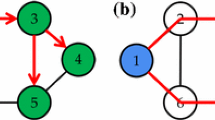Abstract
This paper addresses the problem of achieving full and fast restoration to tolerate as many faults as possible in wavelength-routed wavelength division multiplexing (WDM) networks with no wavelength conversion. We model the problem of finding the maximum number of faults tolerated as a constrained ring cover problem, which is a decomposition problem of exponential complexity. Three heuristic methods which guarantee that at least one fault can be tolerated are proposed. The Ear Decomposition (ED) method can always generate a decomposition to guarantee that only one fault can be tolerated. The Planar Decomposition (PD) method, which takes advantage of the bipartite graph model to generate a decomposition, can tolerate up to f faults, where f is the maximum cardinality between the two bipartite vertex sets. The Maximally Separated Rings (MSR) method uses the greedy method to find a decomposition to tolerate as many faults as possible. The marked-link (ML) method is also proposed to enhance the performance by marking some links, which are originally used for protection, available for normal transmissions. Finally, we also evaluate the number of faults tolerated and the blocking probabilities of these methods in three example networks.
Access this chapter
Tax calculation will be finalised at checkout
Purchases are for personal use only
Preview
Unable to display preview. Download preview PDF.
Similar content being viewed by others
References
M. Medard, S. G. Finn, and R. A. Barry, “WDM Loop-back Recovery in Mesh Networks” Proc. Infocom’ 99, pp. 752–759, Mar 1999.
S. Ramamurthy and B. Mukherjee, “Survivable WDM Mesh Networks, Part I-Protection” Proc. Infocom’ 99, pp. 744–751, Mar 1999.
Y. Miyao and H. Saito, “Optimal Design and Evaluation of Survivable WDM Transport Networks” IEEE J. Select. Areas Commun., vol. 16, no. 7, pp. 1190–1198, Sep. 1998.
O. Gerstel, et al., “Fault Tolerant Multiwavelength Optical Rings with Limited Wavelength Conversion” IEEE J. Select. Areas Commun., vol. 16, no. 7, pp. 1166–1178, Sep. 1998.
S. Baroni, et al., “Link failure restoration in WDM Optical Transport Networks and The Effect of Wavelength Conversion” Proc. Int’l Conf. Optical Fiber Communication, pp. 123–124, Feb 1997.
R. Barry and P. Humblet, “Models of Blocking Probability in All-Optical Networks with and Without Wavelength Changers” IEEE J. Select. Areas Commun., vol. 14, no. 5, pp. 858–866, June 1996.
G. Ellinas and T. Stern, “Automatic Protection Switching for Link Failures in Optical Networks with Bi-directional Links” Proc. IEEE Int’l Conf. Globecom, pp. 152–156, Nov. 1996.
S. Even, “Graph Algorithms,” Computer Science Press, 1979.
C. Li and R. Ramaswami, “Automatic Fault Detection, Isolation, and Recovery in Transparent All-Optical Networks” IEEE J. Lightwave Technol., vol. 15, no. 10, pp. 1784–1793, Oct. 1997.
S. G. Finn, M. Medard, R. A. Barry, “A New algorithm for bi-directional link self-healing for arbitrary redundant networks,” Proc. Int’l Conf. Optical Fiber Communication, pp. 298–299, Feb 1998.
Yannakakis, M., “The effect of a connectivity requirement on the complexity of maximum subgraph problems” J. ACM, pp. 618–630, May1979.
Author information
Authors and Affiliations
Editor information
Editors and Affiliations
Rights and permissions
Copyright information
© 2001 Springer-Verlag Berlin Heidelberg
About this paper
Cite this paper
Sue, CC., Kuo, SY. (2001). Restoration from Multiple Faults in WDM Networks without Wavelength Conversion. In: Lorenz, P. (eds) Networking — ICN 2001. ICN 2001. Lecture Notes in Computer Science, vol 2093. Springer, Berlin, Heidelberg. https://doi.org/10.1007/3-540-47728-4_31
Download citation
DOI: https://doi.org/10.1007/3-540-47728-4_31
Published:
Publisher Name: Springer, Berlin, Heidelberg
Print ISBN: 978-3-540-42302-7
Online ISBN: 978-3-540-47728-0
eBook Packages: Springer Book Archive




